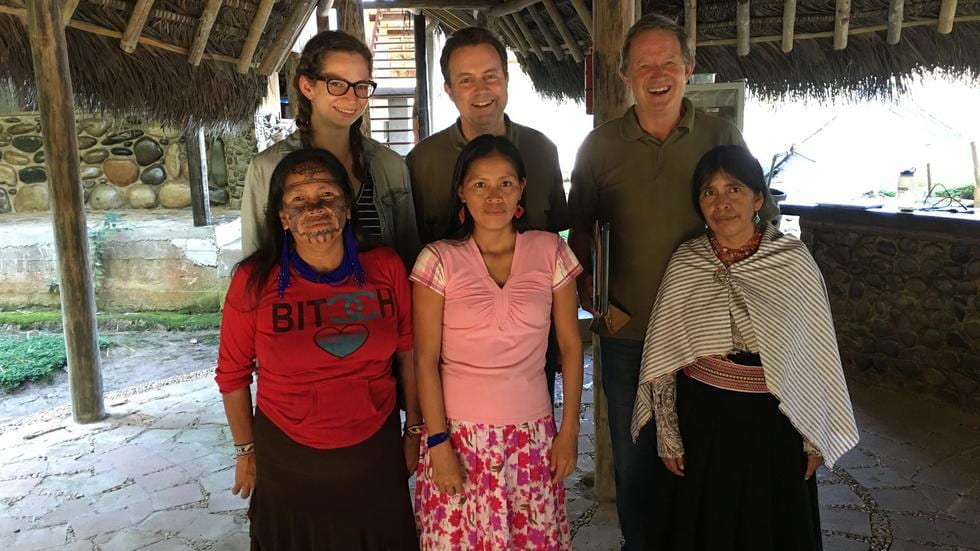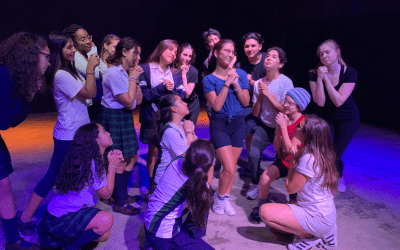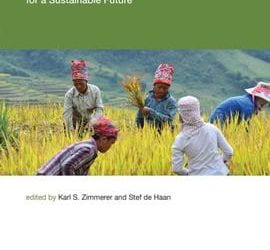Studying the Languages of the Andes
Disappearing… and Evolving
As a young student, I was quite determined to do research in South America. (I am not sure why, but it may have to do with the fact that I was born in the mining region of Bolivia, where my father was a Dutch mining engineer.) After finishing up my undergraduate work in Spanish and Latin American Studies at Yale, I went on to complete a master’s in linguistics in Amsterdam. It was 1974 and my then wife, Patricia Menges, became a Peace Corps volunteer in Ecuador working in Quechua-Spanish bilingual education. As a “financially dependent spouse” I received $10 extra a month on top of Patricia’s regular $100 and some expense money for two years. I wrote my doctoral thesis about the history of indigenous language Quechua in Ecuador on that budget. That is how I started researching the languages of the Andes.
In 1978 I started working at the University of Amsterdam. At that time there was an influx of students from Surinam and the Antilles to Amsterdam. I was confronted every day with a city becoming more and more diverse; therefore, my interest started growing in multilingualism and language contact, the languages of the Caribbean area and migrant languages. The beginning of an exciting trajectory of research and teaching.
The presence of experimental linguistics at the Max Planck Institute for Psycholinguistics persuaded me to start working in Nijmegen, in the eastern part of the Netherlands, in 2001. For a long time, linguists were field workers with a tape recorder; the idea that you could also study language in an experimental setting was new and attractive. What connected me to other Nijmegen linguists at the University and the Max Planck Institute is the search for language variation and language evolution. Our approaches differed, but that is good for progress. Increasingly, language and cognitive scientists are searching together for the similarities and differences that explain language development and variation.
There is more and more—and closer—cooperation between linguists and specialists in psychology, communication and anthropology: a good way to strengthen research in language and communication as a coherent field of study, a way to keep our research lively and exciting.

In the picture (back) Georgia Ennes (U Michigan, now Penn State), Tod Swanson (Arizona SU, Field School director), in the front Francisca, Elodia, Bélgica, speaking three Kichwa varieties. The Andes and Amazon Field School has various sources of funding, including the US Department of Education.
The Lenguas de Bolivia (LB) project
In 1998 I received the Dutch Spinoza prize, a large grant which helped me start a project on the highly endangered languages in Bolivia. To give an impression of the complexity: in South America: there are 117 language families that are totally distinct. In Europe there is just one large family—Indo-European —, traditionally spoken, one smaller family—Finno-Ugrian —and a small separate language—Basque. (There is also a variety of Arabic on Malta, of course, and Turkish in the European part of Turkey). The large degree of diversity in languages in South America continues to intrigue us linguists. Why do languages remain separate, while others do not? Why do all these separate languages emerge at all?
Despite the great cultural and linguistic wealth of the country (in dramatic contrast to its economic development), the knowledge of Bolivian languages and cultures was very limited until recently. There is no national tradition of linguistic research, hardly any trained Bolivian linguists. Native speakers of indigenous languages with training and interest in their own language belong mostly to the two largest groups, Quechua and Aymara. Most research was and is done by foreigners, and the results, in so far as published at all, are hardly available in Bolivia itself, and mostly in English, French or German. Written, moreover, with a lot of technical linguistic terminology. Unfortunately, Western scholars often achieve excellent research results and build their careers on data acquired in the Third World, while the local population, and particularly the people who collaborated in the project, never get to see any result. (To be fair, linguistic work carried out by missionary groups such as the Maryknolls and the Jesuits did include immediate feedback for indigenous populations; in Bolivia it mostly targeted Quechua.)
This is all the more important since there were over thirty languages spoken in the country until recently, many of them without a known affiliation and with structurally unique characteristics. The large majority of these is under severe threat of disappearance, and it is likely that around the year 2100 no more than a handful of languages out of more than thirty will continue to be spoken.
With theLenguas de Bolivia (LB) book publication project, which ran from 2000 to ultimately 2016,we hoped to have at least make knowledge about the languages available, offering brief descriptions in Spanish of the languages and linguistic situation of Bolivia. We map the amazing linguistic diversity of Bolivia, much of which is about to disappear. Also, through these books these languages may be revived, and the attention to cultural and linguistic diversity stimulated. LBconsists of four volumes, containing chapters of approximately 40 pages for each of about thirty languages, written in an understandable and accessible way. They were published between 2008 and 2016 by Plural Editores in La Paz, Bolivia. LBtries to cover the entire Bolivian linguistic landscape. While the first three volumes are dedicated to the languages of the Altiplano and foothills (I), the Bolivian Amazonian lowlands (II), Moxos, Oriente, and Chaco (III), the fourth volume concerns more general topics related to the linguistic setting, such as the standardization of alphabets, the relation between language and culture, as well as varieties of Bolivian Spanish.. To carry out this work all or almost all the specialists in this field were brought together, including a number of Bolivian researchers, when available.
More than twenty authors from more than thirteen countries contributed and over ten years of field work went into it. An important share of the field work was done by student researchers from my own group, including also Mily Crevels (now at Leiden University), who did the lion’s share of the editorial work. LB describes in a clear and easy-to-read way all still spoken and—as far as there is something known—also the extinct languages of Bolivia in sketches of about forty pages. The books are aimed at a wide audience and have been placed at the disposal of public and university libraries, while for sale at a reasonable price in Bolivian bookstores.
My own interest in processes of language mixing and change due to contact were amply satisfied in the work in Bolivia. I will give three examples.
Multilingualism among the Uru
The Bolivian altiplano [high plain] is now predominantly Aymara- and Spanish-speaking, but in earlier times several other small language families were present. One is Puquina, a language which may ultimately be related to the Arawakan language family (a large family of languages spoken throughout the Amazon). Puquina has been extinct for perhaps almost a century. Some of its vocabulary has been preserved in the mixed language Kallawaya (see below).
The other small language family is the one that concerns us here, Uru, one branch of which used to be spoken in the community of Irohito [´iru´witu], located on the banks of the Desaguadero river, near Lake Titicaca. In good times, the river is very wide at this point, although mostly rather shallow. It contains (or used to until recently) a rich ecosystem with totoras(reeds), water plants, fish and water birds. Uru are completely dependent on the river. They hunt and fish (selling their surplus catch elsewhere) and feed their cattle with reeds and plants from the river. In earlier times, the totorasplayed an even more important role, serving as the basic material for their reed boats, and for the roofs of their houses. Now boats are made of wood, and roofs of various brought in materials. Nonetheless, dependence on the river is still the hall mark of Uru life. As far as we know, the community has never been very large, ranging from seven in the earliest source to as many as eighty in the early 20th century. Currently, about 220 people live some of the time in Irohito, but they now mostly speak a larger indigenous language, Aymara. recurrent droughts are a result of glaciers melting due to global warming has put life by the riverside at risk; more and more Uru’s spend time in the slums surrounding La Paz.
From what we can establish, the traditional Uru language has also adapted internally to Aymara. A number of Aymara words and word endings have been borrowed into the language, and it has partly changed its grammatical profile. Thus it has taken over the inclusive (we with you) / exclusive (we without you) distinction. Also, the order of the verbs in a more complex sentence are now more Aymara-like, as in wiril xala kaya pek’uchay [I llama buy want] ‘I want to buy a llama,’ where before it would have been [want buy] as in English.
Thus Uchumataqu gave way to Aymara in the speech community, and this was accompanied by the restructuring of the moribund language in its final stages.
Kallawaya
In an area in the north of Bolivia, Charazani, we find Kallawaya, a ritual healing language only used by male adults, in which lexical roots in part from the ancestral language Puquina are combined with endings from the larger language Quechua. The professional ritual healers from the Charazani region north of La Paz in Bolivia use a secret language.
The name of the group itself for its language is machchaj juyai, “speech of the men.” Kallawaya is rather the name of the group and its esoteric language was called Pohena by one researcher. I suppose that this word reflects the name Puquina, a language now long extinct. It is not clear how much Kallawaya is still spoken; the reports are not very consistent.
The area of Charazani is a Quechua-speaking island in the middle of a generally Aymara speaking region. The area originally was Puquina speaking, as far as we know at least. Puquina was very possibly associated with the old empire of Tiwanaku, in a rim around Lake Titicaca. Kallawaya closely resembles Quechua, but Quechua ri“go” is replaced by isna,mana“not” by u, and willa“tell” by uri.
| Kallawaya | isnapunki | u | urikuspa |
| Quechua | ripunki | mana | willakuspa |
| you went away | not | telling | |
| “You went away without telling (me).” | |||
With these replacements the Kallawaya can disguise their Quechua into a secret incomprehensible language, as befits these professional healers. Some of the replacements come from the old language, Puquina, while others may have been made up or have an unknown origin.
Spanish in Bolivian Quechua
The variety of Quechua which has probably undergone most influence from Spanish without giving way to the dominant language is Bolivian Quechua, particularly as spoken in the province of Cochabamba. It is a vital language, also used in urban contexts, though less so in the center of the city of Cochabamba itself. There are over two million speakers of the language in Bolivia.
The use of Spanish word endings is striking in this form of Quechua. Diminutive—ituoccurs with Quechua words that end in (u), disregarding mostly their gender in Spanish (where –itowould occur with masculine words). Thus, we have punqu “door,” punq–itu“little door” (recall that the equivalent Spanish word puertais feminine, and would become puertita). Diminutive –ita occurs after Quechua words that end in (a), as with uma‘head’ and um–ita“little head.” Quechua itself has no grammatical gender, so it is mostly the form of the word that determines the ending. Finally –situoccurs with Quechua words that end in (i), as with rumi “stone,” rumi–situ“little stone.” You can say that they have taken Spanish diminutives here, but gave them their own rules, not based on gender but on word ending.
In the same way, the form of the plural depends on the word ending. Words that end in a vowel generally get Spanish –s, as with warmi-s “women.” Words that end in a consonant get a Quechua plural, –kuna, as in ñan-kuna“roads.” Again, adaptation to Spanish, but in a creative way, following new rules and patterns.
Back in Ecuador
Thus, the complex language situation of Bolivia continues to amaze, and will yield many other secrets (such as exciting work by colleagues on Afro-Bolivian Spanish and work of my own on the language of the silver mines of Potosí). However, I decided to go back to Ecuador, and redo my doctoral thesis work, but now with the benefit of hindsight gained from forty years of research. I just finished that and have started on a language of the jungle called Waorani or Wao Tededo. More on that to come.
Fall/Winter 2019-2020, Volume XIX, Number 2
Pieter Muysken (1950) is a reluctantly emeritus professor of linguistics at Radboud University Nijmegen, The Netherlands. Previously he taught in Amsterdam and Leiden. His publications are in the fields of Quechua, syntax, creole languages, and bilingualism and language contact.
Related Articles
Bilingualism in Perú
“What does Gloriosky mean?” Mateo asked me. Gloriosky? How do I explain a term typically used in older vaudeville Broadway shows and movies? How do I contextualize this for a Peruvian student with zero reference to this type of genre? These are the kinds of questions that…
De-encapsulated Bilingual Education in Brazil
One school in São, Paulo, Brazil—with which co-author Susan Clemensha is very involved— is striving to create multilingual and multicultural contexts for learning, distancing itself from the…
Agrobiodiversity: Integrating Knowledge for a Sustainable Future
I initially approached the volume titled Integrating Knowledge for a Sustainable Future as an outside observer. As an archaeologist whose research focus is ancient agriculture, my expertise…





